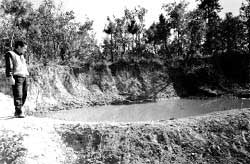Talking of terraces
Talking of terraces

According to J Kire, former director of the soil conservation department of Nagaland, the entire community participates in building terraces. A report in the Indian Journal of Hill Farming has this to say of the practice:
"Area proposed for terracing is cleared by cutting and burning the jungle. The width of the terrace depends upon the slope, keeping the height of the risers (vertical pieces connecting two treads in a stair) to one-two m on an average. Contour lines are drawn by scrapping the topsoil upwards so that the subsoil layer is exposed for a firm foundation. After removing the thin topsoil layer, the sub-soil below the proposed riser, where the subsoil is kept exposed, is dug and heaped up for compaction with wooden dubs vertically and horizontally to form the riser and the side bond. After the riser is property made, the space left behind and above is filled up with stones and shales removed while digging. Leveling of the terrace is done by haff-cut and half-fill methods, by pressing and compacting the filled soil with feet and sticks, taking cam that the topsoil is not buried. After the terrace is thoroughly leveled and completed, the topsoil, earlier removed and kept aside, is spread evenly over the surface of the terrace. Weathered shales collected from the nearby forests are also spread over the terraces. As soon as these come in contact with water they disintegrate and form a fine day layer which blocks the pore spaces and stops seepage and percolation. The terraces are constructed from bottom upwards so that the topsoil from the upper proposed terrace is removed and thrown to fill the terrace just completed below. Leaves and twigs of alder, albizia and other trees and trashes are added to the newly constructed terraces; and allowed to decompose and fertilise the soil. Initially, beans, Naga dal, pumpkins, potatoes etc we grown to recondition the soil for cultivation."
The above description Is true of all terrace construction. But there are certain differences with respect to details. If the source of water for a terrace is a stream or river, then the topsoil is not removed before the terrace is made. it Is spread again over the land once the terracing is complete, as described above. This is because streamwater carries with it enough sediments and suspended matter which soon form a layer over the surface.







